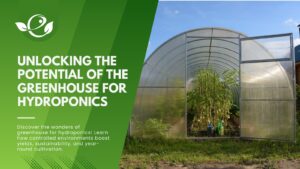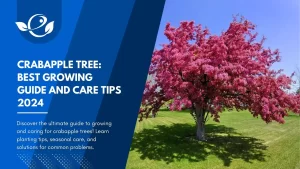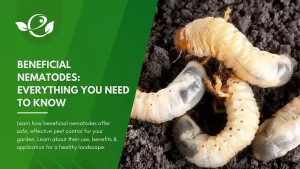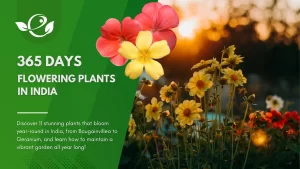Table of Contents
Aphids, often referred to as plant lice, are one of the most common and destructive pests found in gardens and agricultural settings worldwide. These tiny, soft-bodied insects thrive in various climates and environments, making them a pervasive issue for both amateur gardeners and professional farmers.
Aphids feed by piercing plant tissues and sucking out the sap, which weakens the plant and can lead to yellowing, stunted growth, and even death if left uncontrolled. Additionally, aphids excrete a sticky substance known as honeydew, which attracts ants and serves as a breeding ground for sooty mould, a black fungus that further damages plants by blocking sunlight. This detailed article (“How to get rid of aphids”) provides comprehensive information on aphid control methods, structured logically for easy reading and implementation.
Identifying Aphids
Description of Aphids’ Appearance
- Scientific name: Aphis
They are tiny, soft-bodied insects that can vary in colour from green, yellow, black to red. They are pear-shaped, with long antennae and two tubes called cornicles projecting from their abdomen. Green peach aphid (Myzus persicae) are the most common aphid species found feeding on many plant species in the garden and the landscape. Another common aphid is the oleander aphid or the milkweed aphid (Aphis nerii). This aphid feeds on oleander, milkweeds, and their relatives.
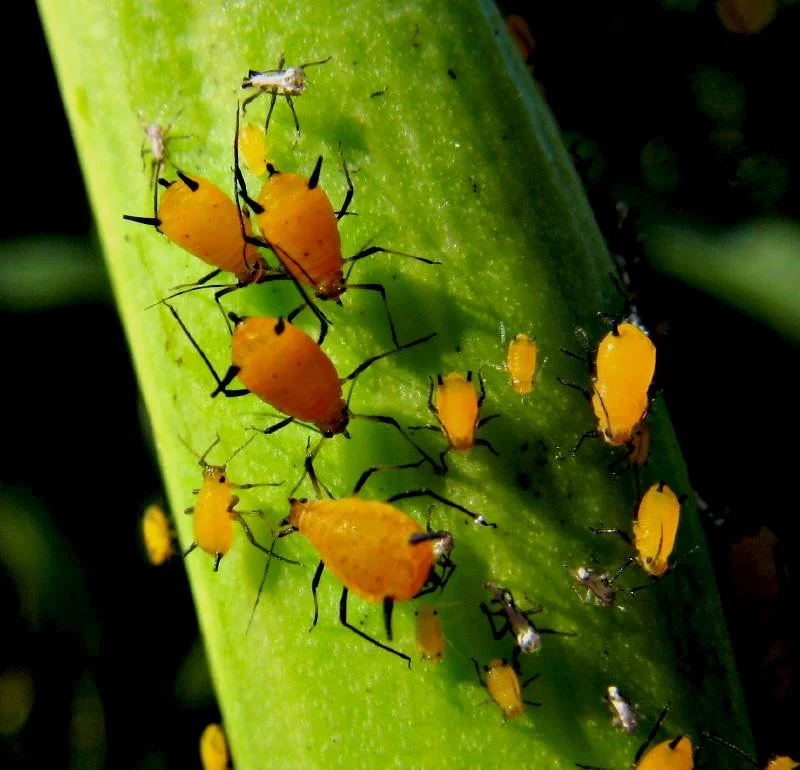

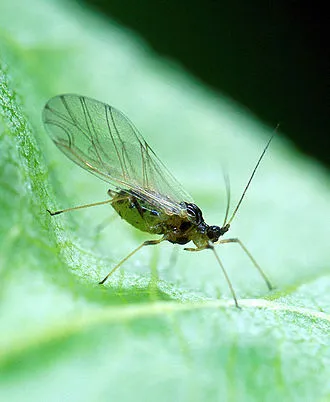
Signs of Aphid Infestation
Low to moderate numbers are usually not harmful to crops. Severe infestation can cause leaves and shoots to curl, wilt or yellow and stunt plant growth. A general decline in plant vigour will be noticed. These insects produce honeydew that can cause an additional infection by opportunistic fungi, indicated by the development of mould on the leaves. The honeydew also attracts ants. Even small numbers of aphids can transmit viruses from plant to plant in a persistent way.
- Sticky residue (honeydew): Aphids excrete a sugary substance called honeydew, which can coat leaves and stems, attracting ants and promoting the growth of sooty mould.
- Curling, yellowing, or stunted leaves: Aphid feeding can distort new growth, causing leaves to curl, yellow, or become stunted.
- Presence of sooty mould: This black, powdery fungus grows on the honeydew left by aphids, further damaging the plant.
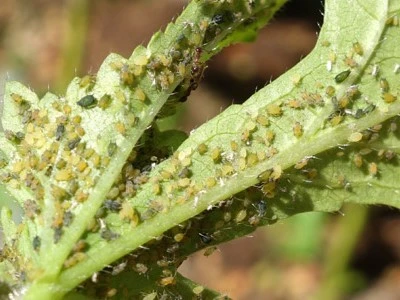
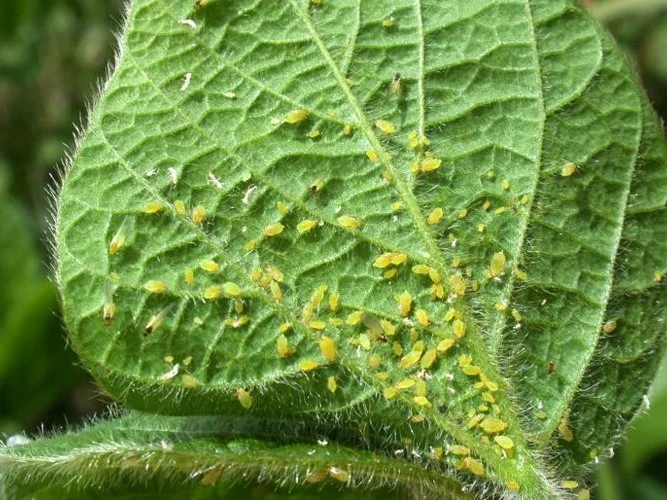
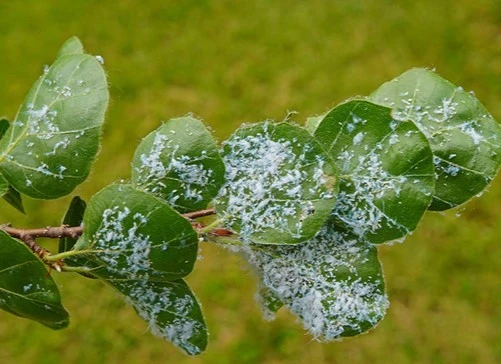
It can usually be found on young tender growth and on the underside of leaves. Plant symptoms typically are a response to their feeding. Aphids have piercing sucking mouth parts. Some species inject toxins into the plant when they feed; these toxins can cause the tissue to become distorted and deformed. A sign of aphids being present is honeydew, the aphid’s sticky excretion, on plant surfaces. Honeydew looks similar to a sugary drink being poured on a plant’s leaves that have dried and have a sticky appearance and feel.
Plants Commonly Affected by Aphids
It can infest a wide range of plants, including Almonds, Apple, Apricot, Banana, Barley, Bean, Bitter Gourd, Cabbage, Canola, Carrot, Cauliflower, Cherries, Chickpeas & Gram, Citrus, Coffee, Cotton, Cucumber, Currant, Brinjal, Garlic, Ginger, Black & Green Gram, Grape, Guava, Lentil, Lettuce, Maize, Mango, Cassava, Melon, Millet, Okra, Olive, Onion, Papaya, Pea, Peach, Peanut, Pear, Capsicum & Chili, Pumpkin, Rice, Rose, Sorghum, Soybean, Strawberry, Sugar, Beet, Sugarcane, Sweet Potato, Tobacco, Tomato, Turmeric, Wheat, Zucchini and many ornamental plants.
What caused it?
Aphids are small, soft-bodied insects with long legs and antennae. Their size ranges from 0.5 to 2 mm and the colour of their body can be yellow, brown, red or black, depending on the species. Their aspect ranges from the wingless varieties, that are generally predominant, to the winged, waxy or woolly types. Optimal conditions for their growth are dry and warm climates.
They usually settle and feed in clusters on the underside of well-fed young leaves and shoot tips. They use their long mouth parts to pierce tender plant tissues and suck out fluids. After an initial invasion in late spring or early summer, the aphid population usually diminishes naturally due to natural enemies. Several species carry plant viruses that can lead to the development of other diseases.
Natural Aphid Control Methods
A. Biological Controls
- Ladybugs: These predators can consume large numbers of aphids.
- Lacewings: Their larvae, known as “aphid lions,” are voracious aphid predators.
- Parasitic Wasps: These wasps lay their eggs inside aphids, eventually killing them.
- Birds: Many bird species feed on aphids.
- Other Beneficial Insects: Predators like spiders and predatory beetles can help control aphid populations.
B. Manual Removal
- Regularly inspect your plants.
- Remove these insects by hand or use a strong stream of water to dislodge them.
C. Homemade Solutions
In case of mild infestation, use an insecticidal soap solution or solution based on plant oils, e.g. neem oil (3 ml/l). These are also very susceptible to fungal diseases when it is humid. A spray of water on affected plants can also remove them.
- Soap and Water Spray: Mix a few drops of dish soap with water and spray directly on aphids.
- Neem Oil Spray: Horticultural oils, such as neem oil or mineral oil, can smother aphids and their eggs. They are effective when applied as a spray, especially during the dormant season to target overwintering aphids. Neem oil (3 ml/l) disrupts aphid feeding and reproduction.
- Garlic or Onion Spray: These natural sprays can repel aphids effectively.
Chemical Aphid Control Methods
A. Chemical pesticides
Always consider an integrated approach with preventive measures together with biological treatments if available. Be aware that the use of chemical pesticides can cause aphids to become resistant to those that are used. Stem application with flonicamid and water (1:20) ratio at 30, 45, 60 days after sowing (DAS) can be planned. Fipronil 2 ml or thiamethoxam (0.2 g) or flonicamid (0.3 g) or acetamiprid (0.2 per liter of water) can also be used. However, these chemicals can have negative impacts on predators, parasitoids, and pollinators.
C. Safety Precautions
- Environmental Impact: Use chemicals as a last resort to minimize harm to the environment.
- Protecting Beneficial Insects and Pollinators: Avoid spraying during blooming periods and target only infested areas.
- Proper Usage and Storage: Follow label instructions carefully and store chemicals safely.
Preventive Measures of Aphid Infestations
- Maintain a high number of different varieties of plants around fields.
- Remove plant debris from previous cultures.
- Use reflective mulches to repel invading populations of aphids.
- Monitor fields regularly to assess the incidence of a disease or pest and determine its severity.
- Remove infected plant parts.
- Check weeds in and around the fields.
- Do not over-water or over-fertilize.
- Control ant populations that protect aphids with sticky bands.
- If possible, use nets to protect the plants.
- Control insecticide use in order not to affect beneficial insects.
- Prune the branches of your trees or remove the bottom leaves of your plants to favour the ventilation of
the canopy.
Integrated Pest Management (IPM)
Integrated Pest Management (IPM) is a comprehensive approach to pest control that combines multiple strategies to manage pests effectively, economically, and with minimal impact on the environment. IPM emphasizes the use of a variety of control methods to keep pest populations at manageable levels while reducing the reliance on chemical pesticides. This section explores the principles of IPM, the various methods involved, and how they can be integrated to provide long-term, sustainable aphid control.
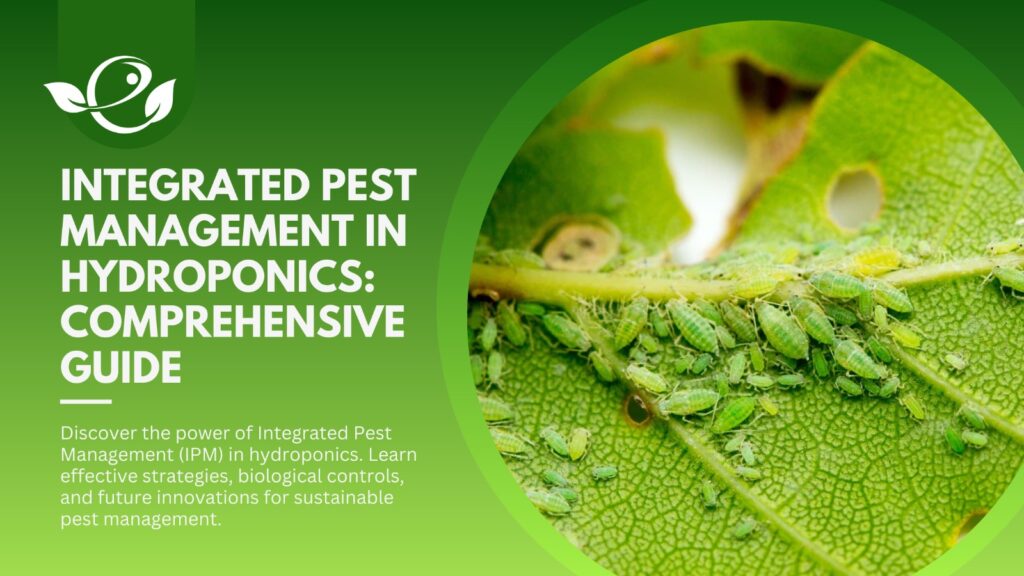
Integrated Pest Management is an ecosystem-based strategy that focuses on long-term prevention and control of pests through a combination of techniques such as biological control, habitat manipulation, cultural practices, and the use of resistant varieties. The principles of IPM include:
- Prevention: Implementing practices that reduce the risk of pest outbreaks.
- Monitoring: Regularly scouting and monitoring pest populations and plant health.
- Identification: Correctly identifying pests to ensure appropriate control measures.
- Threshold Levels: Establishing action thresholds to determine when pest control measures should be applied.
- Control: Applying a combination of biological, cultural, physical, and chemical control methods when needed.
A. Combining Methods
Biological Controls:
- Beneficial Insects: Introducing or conserving natural predators such as ladybugs, lacewings, and parasitic wasps.
- Microbial Controls: Using entomopathogenic fungi, bacteria, or viruses that specifically target aphid.
Cultural Controls:
- Crop Rotation: Changing the types of crops grown in a particular area to disrupt the pest life cycle.
- Sanitation: Removing plant debris and weeds that can harbour aphids and other pests.
- Resistant Varieties: Planting aphid-resistant plant varieties to reduce susceptibility.
Physical Controls:
- Mechanical Removal: Manually removing or using water sprays to dislodge them.
- Barriers and Traps: Using row covers, sticky traps, or reflective mulches to deter or capture these insects.
Chemical Controls:
- Selective Use of Pesticides: Applying chemical treatments as a last resort and selecting products that have minimal impact on beneficial insects and the environment.
- Spot Treatment: Targeting specific areas with high aphid populations to reduce overall chemical usage.
B. Long-Term Strategies
Sustainable Aphid Management Practices:
- Habitat Management: Creating a garden environment that supports beneficial insects and reduces aphid populations. This includes planting diverse crops and providing habitats such as hedgerows and insect hotels.
- Regular Monitoring and Record-Keeping: Keeping detailed records of pest occurrences, monitoring results, and control measures applied. This information helps in understanding pest dynamics and improving future management practices.
- Education and Training: Staying informed about the latest IPM techniques and educating others about the benefits of IPM. This can include attending workshops, reading scientific literature, and participating in gardening communities.
Adopting a Holistic Approach:
- Recognizing that pest management is part of a broader ecological system and making decisions that enhance the overall health of the garden or farm ecosystem.
- Encouraging natural balances and avoiding practices that can lead to pest resistance or environmental harm.
Conclusion
Controlling aphids requires a proactive and integrated approach. By identifying aphids early, using a combination of natural, organic, and chemical methods, and implementing preventative measures, you can effectively manage aphid infestations and protect your plants. Remember, a healthy garden starts with regular monitoring and timely intervention. Effective aphid control requires vigilance and consistency. Regularly inspecting your plants, implementing preventative measures, and responding promptly to early signs of infestation will help keep aphid populations under control. Remember that healthy plants are less susceptible to pests, so focusing on overall plant health is crucial.
By integrating the various methods discussed in this article and adopting a proactive and informed approach, you can effectively manage aphid infestations and enjoy a thriving, healthy garden. Remember, the goal is not necessarily to eliminate this insect entirely but to maintain their populations at a level where they do not cause significant harm to your plants.
FAQ
Which is the best method of controlling aphids?
The best method of controlling aphids is using Integrated Pest Management (IPM), which combines biological, cultural, physical, and chemical control methods for effective and sustainable aphid management.
What is the best aphid killer?
Neem oil is considered one of the best aphid killers due to its effectiveness in disrupting aphid feeding and reproduction while being safe for plants, humans, and beneficial insects.
What will keep aphids away?
Maintaining healthy plants, practising companion planting with aphid-repellent plants like marigolds and garlic, and regularly inspecting and removing aphids can keep them away.
What are homemade aphid killers?
1. Soap and water spray (a few drops of dish soap in water)
2. Neem oil spray (neem oil mixed with water)
3. Garlic or onion spray (blended garlic or onion mixed with water)
How to spray for aphids?
Mix your chosen solution (soap water, Neem oil (3 ml/l), etc.).
Fill a spray bottle with the solution.
Spray directly on aphids, ensuring thorough coverage of affected plant areas.
Repeat every few days until they are gone.
Which one is useful to get rid of aphids?
Try horticultural oil, such as neem oil or mineral oil, can smother aphids and their eggs. Neem oil spray, introducing beneficial insects like ladybugs, and using insecticidal soap are effective strategies.
What attracts aphids?
Aphids are attracted to plants with new, tender growth, high nitrogen levels from over-fertilization, and plants weakened by stress or disease.
Can I spray dish soap on aphids?
Yes, spraying a solution of dish soap and water on aphids can effectively kill them. Use a few drops of dish soap in a spray bottle filled with water and apply directly to aphids.
Do ants eat aphids?
No, ants do not eat aphids. Instead, ants farm aphids for their honeydew, a sugary substance aphids excrete, and protect them from predators.
What is the best homemade aphid killer?
The best homemade aphid killer is a soap and water spray. Mix a few drops of dish soap with water in a spray bottle and apply it directly to the aphids on your plants.

